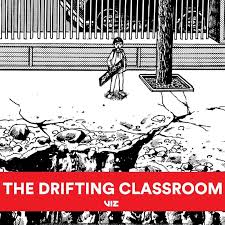 By KAZUO UMEZU (Viz Media; 1974-75/2006-08)
By KAZUO UMEZU (Viz Media; 1974-75/2006-08)
One of the most iconic horror manga series of all time was this sprawling quasi-science fictional saga by writer-illustrator Kazuo Umezu, one of the field’s most singular talents. Initially serialized in Japan back in the mid-1970s, THE DRIFTING CLASSROOM is now available in English in eleven jam-packed volumes, each running around two hundred pages. Getting through the entire saga might seem—and indeed is—a heady proposition, but in common with most manga (which is designed to be read on the go) it’s a fast and easy reading experience overall.
To fully appreciate this series one has to know the conventions of manga, which is: 1). Read from right to left rather than the left-to-right western comic book model, 2). Pitched at an absurdly high emotional level that never wavers (seemingly every page contains at least one close up of a character screaming in front of an exploding-supernova background), 3). Quite startlingly frank in its depictions of brutality and bloodletting (the reason for the “Explicit Content” advisories on the cover of each volume), and 4). Highly reliant on imposing sound effects that often dwarf the dialogue (and, as rendered in English, consist of morsels like “DSSH,” “WRSSH,” “FWOOSH,” etc). If you can accept those things you’ll almost certainly enjoy THE DRIFTING CLASSROOM.
The setting is a Tokyo based elementary school that following an apparent earthquake inexplicably vanishes. In fact, the school and its inhabitants have been transported to a barren wasteland that would appear to offer nothing in the way of food, water or shelter. Worse, one of the teachers goes mad and murders his colleagues, leaving just one adult, the psychotic cafeteria worker Sekiya, who causes all sorts of problems for the untested schoolkids forced to negotiate this new and terrifying reality.
Further obstacles confronting the children include deadly monsters of nearly every conceivable variety (this series often reads like LORD OF THE FLIES crossed with THE MIST), the bubonic plague, an ever-decreasing supply of food and water and flesh-and-blood manifestations of the kids’ fears and anxieties. The smart and resourceful Sho, a sixth grader, becomes a de facto leader due largely to his connection with his aggrieved mother, who remains stuck in the here-and-now but with whom Sho discovers a way to communicate.
I won’t reveal any more of the story, whose consistently suspenseful and unpredictable unfolding is paramount to THE DRIFTING CLASSROOM’S effect, but will express admiration for Kazuo Umezu’s fluid yet logical and scientific imagination that’s capable of rendering the most outrageous flights of fancy in believable fashion, and also the unfailingly robust and energetic storytelling, which consistently throws up seemingly insurmountable obstacles for its heroes, followed by equally ingenious solutions. The whole thing could, however, have been a few hundred pages shorter.
